Unconventional Reservoir Characterization and Formation Evaluation: A Case Study of a Tight Sandstone Reservoir in West Africa
Abstract
:1. Introduction
2. Overview of Study Area
2.1. Nene Marine Field
2.2. Geological Setting
3. Formation Evaluation and Reservoir Characterization
3.1. Rock Quantification
3.2. Geological Characterization
3.3. Quantification of Total Organic Carbon
3.4. Quantification of Porosity and Permeability
3.5. Quantifying Fluid Saturation
- Free gas and oil are contained in inorganic and organic holes and spontaneous cracks in the matrix.
- Sorbed gas and oil are either adsorbed (chemically bonded) to organic matter (kerogen) and mineral surfaces in natural cracks or absorbed (physically bound) to organic matter (kerogen) and mineral surfaces in the rock of the matrix.
- Gas dissolved in the hydrocarbon liquids found in bitumen.
3.6. Assessment of Geomechanical Characteristics
4. Unconventional Reservoir Characterization Workflows
- Fundamental reservoir properties encompass the formation’s electrical resistivity at different investigative depths, formation density to deduce general rock types, neutron density to deduce fluid and gas characteristics, pulsed neutron measurements for determining rock composition and mineral content, total organic carbon (TOC), lithofacies, and micro-resistivity/acoustic readings for creating an accurate depiction of the geological layers, along with nuclear magnetic resonance to attempt to identify kerogens, as well as assess porosity and permeability.
- Anisotropic acoustic properties; the advanced cross-dipole acoustic logging acquisition of compressional (Vp), shear (Vs), and Stoneley-wave data sets. In addition to standard sonic logging, the primary focus of this analysis is to determine the geomechanical properties of the rock and in situ system stresses, and the level of the strain of the mudrock sequences within the wellbore. The 3D anisotropy algorithm transforms the compressional, fast-shear, slow-shear, and Stoneley acoustic slowness measurements, with respect to the borehole axes, into anisotropic moduli referenced to the earth’s anisotropy axes. These moduli help to classify the formation anisotropy into isotropic, transverse isotropic (HTI, VTI), or orthorhombic types. The moduli also assist in micro-layering or thin-bedding-induced TI anisotropy (N < 0 implies micro-layering-induced intrinsic anisotropy; N > 0 implies bedding-induced anisotropy), the relative magnitude of the principal stresses, and fluid mobility. XMACTM-F1/Sound TrakTM tool measurements can be used in evaluating the types of anisotropy, in addition to differentiating between open natural fracture and drilling-induced fracture. Wellbore images of the STARTM, StarTrakTM, GeoxplorerTM, and CBILTM can be combined with XMACTM-F1/Sound TrakTM shear-wave anisotropy so that Stoneley-wave data can be constructed and compared with an independent measurement of rock properties and in situ stresses. Identification of acoustic-derived high-stress and low-stress zonation within the vertical pilot, as correlated to variations in the clay content, can be an important tool for the prediction of the preferred lateral placement within the vertical pilot well. In addition, determining the azimuth of the horizontal maximum stress orientation (Sigma one δ1 horizontal) is a critical part of determining the azimuth orientation for later well placement. A contrast between sigma δ1, δ2, and δ3 within the wellbore is also desired. Acoustic (sonic) logging should also be taken into account to constrain and enhance the matching of seismic data phases and to aid in the conversion of seismic data to depth measurements.
- For rock mineralogy, the FlexTM/RockviewTM SpectrologTM can help determine specific rock lithologies, including clay characterization. The tool applications include the clay fraction independent of gamma-ray, spontaneous potential, and density neutron responses for carbonate, gypsum, or the anhydrite, pyrite, siderite, coal, and salt fractions for complete complex reservoir analysis. Matrix density and neutron measurements are utilized for sophisticated porosity calculations, estimating permeability based on mineral content, and for developing correlations. Quantitative lithology is used for modelling rock properties and pore pressure prediction from seismic data. Geochemical lithostratigraphy (elemental and meteorological lithostratigraphy) is used for well-to-well correlation applications. The types of radioactive elements (Thorium/Uranium) along with their distribution across vertical and horizontal planes are employed to comprehend the depositional elements both within and external to the basin, within the vertical geological section, in order to anticipate zones of potentially greater reservoir capacity(rich zones). This is based on the assumption that factors such as rock brittleness and seal integrity are regulated. This is one example. The significance of each mineral varies by play, depositional environment, and other characteristics.
| Generic Tool Technology | Wireline Tool | LWD Tool | Evaluation Application |
|---|---|---|---|
| Resistivity | HDILTM | OnTrakTM/AziTrakTM | Fluid saturations, TOC determinations |
| Compensated Density Compensated Neutron | ZDLTM/CNTM | LithoTrakTM | Total porosity, lithology, and TOC for basic reservoir properties |
| Cross Dipole Acoustics | XMACTM -F1 | Sound TrakTM | Compressional and shear slowness, static and dynamic mechanical rock properties, geomechanical stress determinations, and fracture identification |
| Gamma Ray Spectral Gamma Ray | GRTM SpectralogTM | GR Included with LWD resistivity service | Lithology, mineralogy, and TOC determination |
| Elemental Spectroscopy | FlexTM RockviewTM SpectrologTM | Lithology, mineralogy, TOC, and lithofacies determination | |
| Resistivity Imaging | STARTM (WBM) GeoXplorerTM (OBM) | Star TrakTM | Quantification structural and sedimentary features, fracture characteristics, and stress |
| Acoustic Imaging | CBILTM UltrasonicXplorerTM | In situ geologic structure and sedimentary analysis Stress determination, fracture identification | |
| Nuclear Magnetic Resonance | MReXTM | MagTrakTM | Kerogen characterization, porosity permeability |
| Fluid and Pressure Testing | RCITM Straddle Packer Micro-FracTM | A modular formation dynamics test for micro-fracturing; evaluation of fracturing closure and the minimum horizontal stress | |
| Rotary Cores | PowerCORTM MaxCORTM | Wireline core analyses |
Complexities of Tight Sandstone Reservoir Development
5. Characterization of the Components of Unconventional Resource Plays
- The amount of oil or gas that may be extracted from a well depends on a number of factors, including the net combination of site-specific reservoir properties and the use of the most suitable finishing technique.
- The selection of the completion target (vertical selection, lateral positioning, lateral stage placement, and lateral stage completions) calls for modern technologies that are both time and cost efficient in the characterisation of the reservoir.
6. Petrophysical Analysis
6.1. Overview of Petrophysical Evaluation Workflow
- Calculating shale volume;
- Calculating porosity;
- Reservoir rock/fluid substitutions;
- Core data depth matching;
- Rock typing;
- Permeability estimations;
- Pore structure investigations;
- Visualizing output data.
6.2. Petrophysical Evaluation of the Available Data
6.2.1. Shale Volume Calculation
6.2.2. Porosity Calculation
6.2.3. Reservoir Rock/Fluid Substitutions
6.2.4. Depth Matching
6.2.5. Rock Typing
6.2.6. Permeability Estimation
Permeability Calculation from the Porosity–Permeability Relationship
NMR Permeability
- SDR equation
- T2LM = logarithmic mean T2;
- = NMR porosity (V/V);
- C1, a1, b1 = coefficients.
- ii.
- Timur-Coates equation
- FFI = free-fluid volume;
- BVI = bound volume irreducible
- = NMR porosity (p.u.);
- C2, a2, b2 = coefficients.
Calculating the Stoneley Permeability Index (KIST)
- Calculating Stoneley FZI
- = Flow Zone Index;
- = Index Match Factor;
- = Permeability Index.
- = Index Match Factor;
- = Each Mineral IMF;
- = Each Mineral Probabilistic Volume (ft3/ft3).
- Calculating Stoneley permeability
- = Permeability (md);
- = Effective Porosity (v/v);
- = Flow Zone Index.
6.2.7. Pore Structure Investigation
Pore Type
- Class I (VDL > +500): indicates intraparticle and moldic or vug pore types.
- Class II (VDL = ±500): indicates micro porosity, interparticle, and intercrystalline pore types.
- Class III (VDL < −500 ): indicates a fracture pore type.

Pore Sizes
- K = core permeability (md);
- Phi = core porosity (%);
- R = pore throat size (micron).
Capillary Pressure
7. Conclusions
Author Contributions
Funding
Data Availability Statement
Conflicts of Interest
References
- Ahmed, U.; Meehan, D.N. (Eds.) Unconventional Oil and Gas Resources: Exploitation and Development; CRC Press: Boca Raton, FL, USA, 2016. [Google Scholar]
- Loucks, R.G.; Reed, R.M.; Ruppel, S.C.; Hammes, U. Spectrum of pore types and networks in mudrocks and a descriptive classification for matrix-related mudrock pores. AAPG Bull. 2012, 96, 1071–1098. [Google Scholar] [CrossRef]
- Miller, C.; Waters, G.; Rylander, E. Evaluation of production log data from horizontal wells drilled in organic shales. In Proceedings of the SPE Unconventional Resources Conference/Gas Technology Symposium, The Woodlands, TX, USA, 14 June 2011; SPE: Santa Clara, CA, USA, 2011; p. SPE-144326. [Google Scholar]
- Passey, Q.R.; Bohacs, K.M.; Esch, W.L.; Klimentidis, R.; Sinha, S. From oil-prone source rock to gas-producing shale reservoir–geologic and petrophysical characterization of unconventional shale-gas reservoirs. In Proceedings of the SPE International Oil and Gas Conference and Exhibition in China, Beijing, China, 8 June 2010; SPE: Santa Clara, CA, USA, 2010; p. SPE-131350. [Google Scholar]
- Waters, G.; Dean, B.; Downie, R.; Kerrihard, K.; Austbo, L.; McPherson, B. Simultaneous hydraulic fracturing of adjacent horizontal wells in the Woodford Shale. In Proceedings of the SPE Hydraulic Fracturing Technology Conference and Exhibition, The Woodlands, TX, USA, 19 January 2009; SPE: Santa Clara, CA, USA, 2019; p. SPE-119635. [Google Scholar]
- Zou, C. Meaning of unconventional petroleum geology. In Unconventional Petroleum Geology; Elsevier: Amsterdam, The Netherlands, 2017; pp. 49–95. [Google Scholar]
- Chekani, M.; Kharrat, R. An integrated reservoir characterization analysis in a carbonate reservoir: A case study. Pet. Sci. Technol. 2012, 30, 1468–1485. [Google Scholar] [CrossRef]
- Metwalli, F.I.; Pigott, J.D.; Ramadan, F.S.; El-Khadragy, A.A.; Afify, W.A. Alam El Bueib reservoir characterization, Tut oil field, North Western Desert, Egypt. Environ. Earth Sci. 2018, 77, 143. [Google Scholar] [CrossRef]
- Oyeyemi, K.D.; Olowokere, M.T.; Aizebeokhai, A.P. Hydrocarbon resource evaluation using combined petrophysical analysis and seismically derived reservoir characterization, offshore Niger Delta. J. Pet. Explor. Prod. Technol. 2018, 8, 99–115. [Google Scholar] [CrossRef]
- Global LNG Info. Available online: https://www.globallnginfo.com/ShowNews.aspx?NewsID=20220000053 (accessed on 30 October 2023).
- McHargue, T.R. Stratigraphic Development of Proto-South Atlantic Rifting in Cabinda, Angola—A Petroliferous Lake Basin: Chapter 19; AAPG: Tulsa, OK, USA, 1990. [Google Scholar]
- Harris, N.B. AAPG Memoir 73, Chapter 24: Toca Carbonate, Congo Basin: Response to an Evolving Rift Lake; AAPG: Tulsa, OK, USA, 2000. [Google Scholar]
- Ma, Y.Z.; Holditch, S. Unconventional Oil and Gas Resources Handbook: Evaluation and Development; Gulf Professional Publishing: Houston, TX, USA, 2015. [Google Scholar]
- Ran, Q. Unconventional Tight Reservoir Simulation: Theory, Technology and Practice; Springer Nature: Berlin/Heidelberg, Germany, 2020. [Google Scholar]
- Jenkins, C.D.; Boyer, C.M. Coalbed-and shale-gas reservoirs. J. Pet. Technol. 2008, 60, 92–99. [Google Scholar] [CrossRef]
- Jacobi, D.; Longo, J.M.; Sommer, A.; Pemper, R. A chemistry-based expert system for mineral quantification of sandstones. In Proceedings of the Petrotech 2007 Oil and Gas Conference and Exhibition, New Delhi, India, 15–19 January 2007. [Google Scholar]
- Jarvie, D.M. Total Organic Carbon (TOC) Analysis: Chapter 11: Geochemical Methods and Exploration; AAPG: Tulsa, OK, USA, 1991. [Google Scholar]
- Sondergeld, C.H.; Newsham, K.E.; Comisky, J.T.; Rice, M.C.; Rai, C.S. Petrophysical considerations in evaluating and producing shale gas resources. In Proceedings of the SPE Unconventional Gas Conference, Pittsburgh, PA, USA, 23 February 2010; OnePetro: Richardson, TX, USA, 2010. [Google Scholar]
- Bustin, R.M.; Bustin, A.; Ross, D.; Chalmers, G.; Murthy, V.; Laxmi, C.; Cui, X. Shale Gas Opportunities and Challenges: AAPG Search and Discovery Article 40382. In Proceedings of the AAPG Annual Convention, San Antonio, TX, USA, 20–23 April 2008. [Google Scholar]
- LeCompte, B.; Franquet, J.A.; Jacobi, D. Evaluation of Haynesville Shale vertical well completions with a mineralogy-based approach to reservoir geomechanics. In Proceedings of the SPE Annual Technical Conference and Exhibition, New Orleans, LA, USA, 4 October 2009; SPE: Santa Clara, CA, USA, 2009; p. SPE-124227. [Google Scholar]
- Walles, F. A New Method to Help Identify Unconventional Targets for Exploration and Development through Integrative Analysis of Clastic Rock Property Fields; AAPG: Tulsa, OK, USA, 2004. [Google Scholar]
- Peeters, M.; Visser, R. A comparison of petrophysical evaluation packages: LOGIC, FLAME, ELAN, OPTIMA, and ULTRA. Log Anal. 1991, 32, 350–357. [Google Scholar]
- Crain, E.R. Crain’s Petrophysical Handbook: Spectrum 2000 Mindware Limited; 2002; Available online: https://www.spec2000.net/index.htm (accessed on 30 October 2023).
- Tiab, D.; Donaldson, E.C. Petrophysics: Theory and Practice of Measuring Reservoir Rock and fluid Transport Properties; Gulf Professional Publishing: Houston, TX, USA, 2015. [Google Scholar]
- Kadkhodaie-Ilkhchi, A.; Amini, A. A fuzzy logic approach to estimating hydraulic flow units from well log data: A case study from the Ahwaz oilfield, South Iran. J. Pet. Geol. 2009, 32, 67–78. [Google Scholar] [CrossRef]
- Ebanks, W.J., Jr. Flow unit concept-integrated approach to reservoir description for engineering projects. In Proceedings of the Conference: American Association of Petroleum Geologists Annual Meeting, Los Angeles, CA, USA, 7 June 1987; Volume 71. [Google Scholar]
- Amaefule, J.O.; Altunbay, M.; Tiab, D.; Kersey, D.G.; Keelan, D.K. Enhanced reservoir description: Using core and log data to identify hydraulic (flow) units and predict permeability in uncored intervals/wells. In Proceedings of the SPE Annual Technical Conference and Exhibition, Houston, TX, USA, 3 October 1993; OnePetro: Richardson, TX, USA, 1993. [Google Scholar]
- Prasad, M. Correlating permeability with velocity using flow zone indicators. In SEG Technical Program Expanded Abstracts 1999; Society of Exploration Geophysicists: Houston, NY, USA; pp. 184–187.
- Kosari, E.; Ghareh-Cheloo, S.; Kadkhodaie-Ilkhchi, A.; Bahroudi, A. Fracture characterization by fusion of geophysical and geomechanical data: A case study from the Asmari reservoir, the Central Zagros fold-thrust belt. J. Geophys. Eng. 2015, 12, 130–143. [Google Scholar] [CrossRef]
- Anselmetti, F.S.; Eberli, G.P. The velocity-deviation log: A tool to predict pore type and permeability trends in carbonate drill holes from sonic and porosity or density logs. AAPG Bull. 1999, 83, 450–466. [Google Scholar]
- Kolodzie, S., Jr. Analysis of pore throat size and use of the Waxman-Smits equation to determine OOIP in Spindle Field, Colorado. In Proceedings of the SPE Annual Technical Conference and Exhibition, Dallas, TX, USA, 21 September 1980; SPE: Santa Clara, CA, USA, 1980; p. SPE-9382. [Google Scholar]
- Altunbay, M.; Martain, R.; Robinson, M. Capillary pressure data from NMR logs and its implications on field economics. In Proceedings of the SPE Annual Technical Conference and Exhibition, New Orleans, LA, USA, 30 September 2001; SPE: Santa Clara, CA, USA, 2001; p. SPE-71703. [Google Scholar]


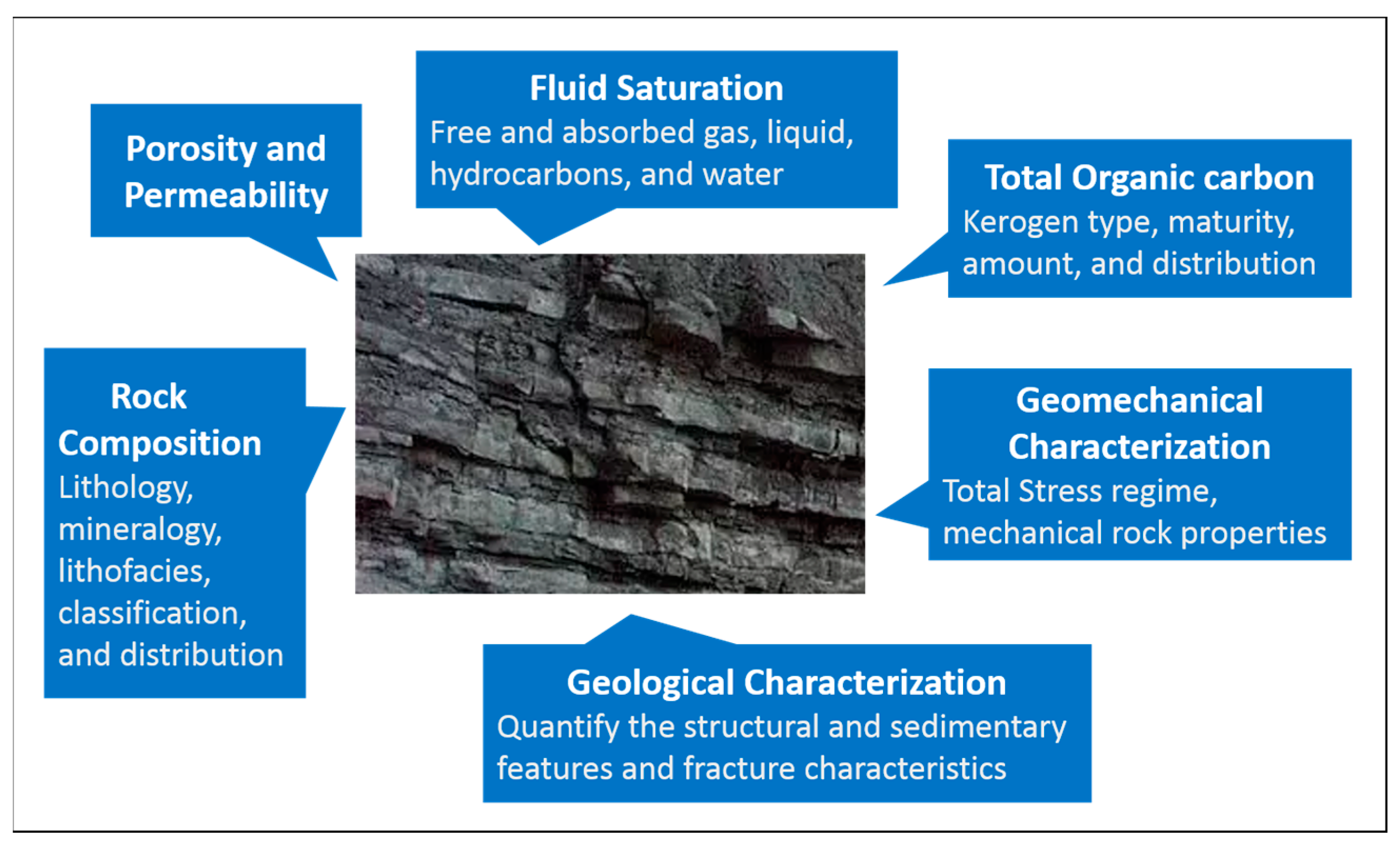
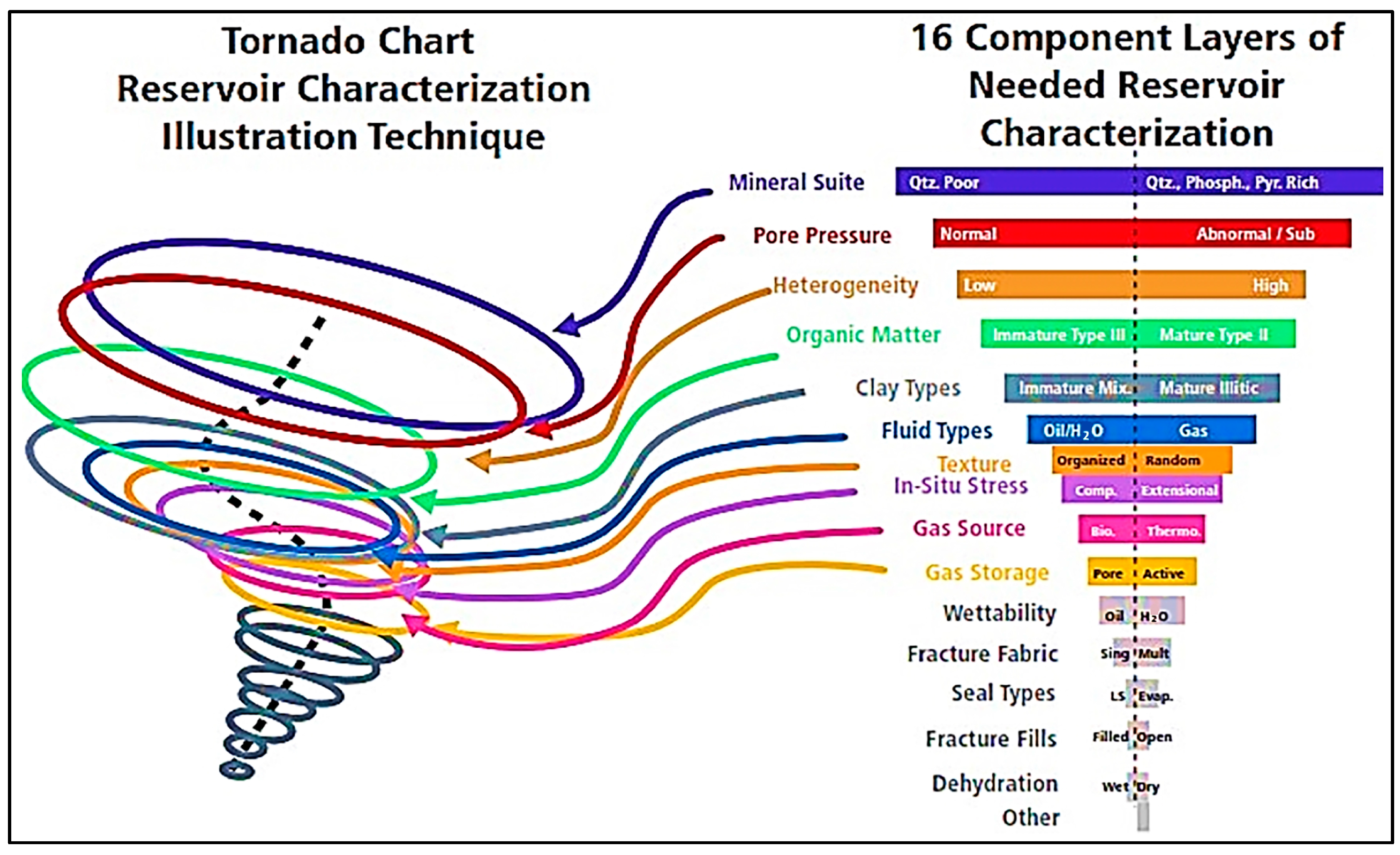

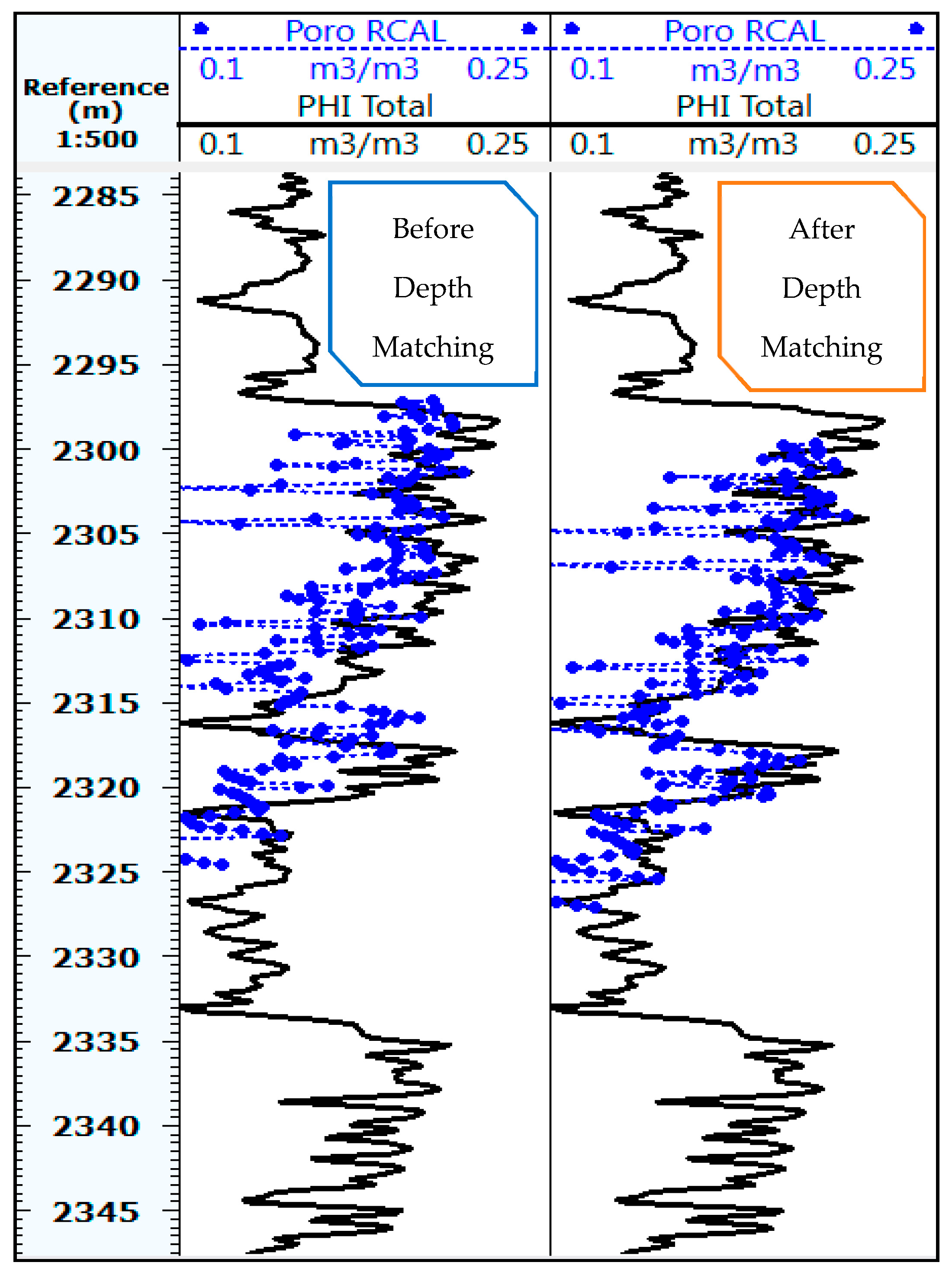
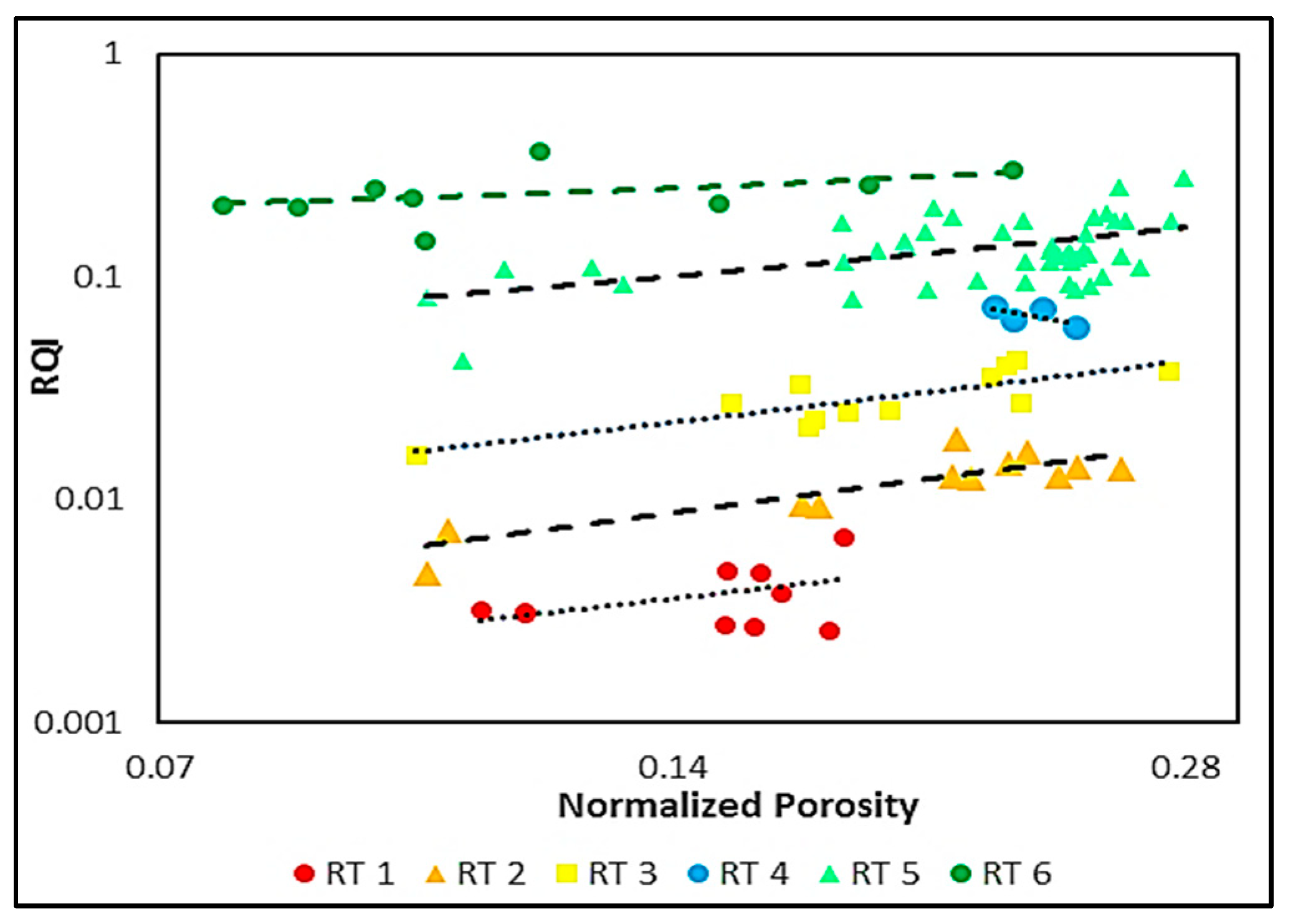
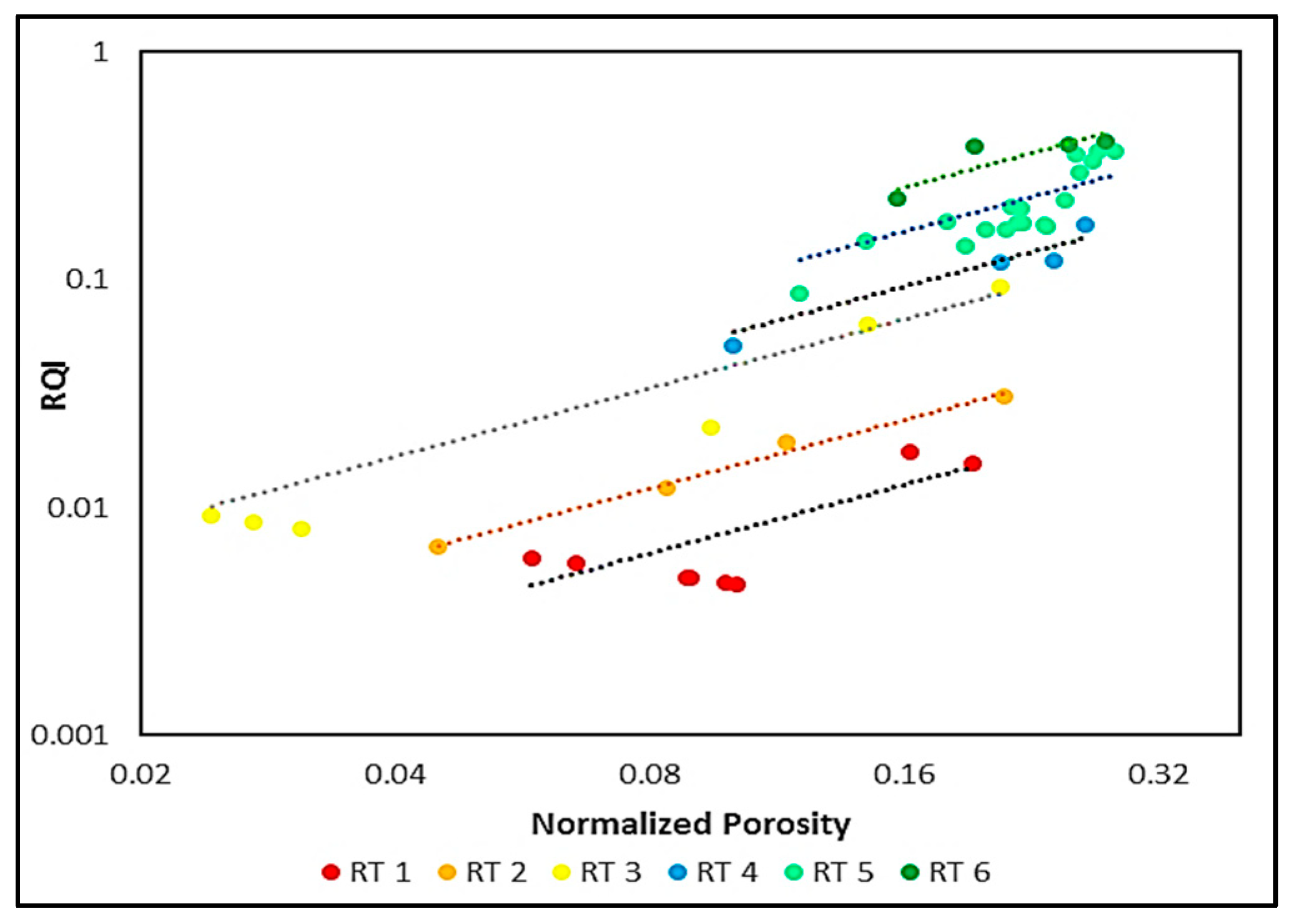
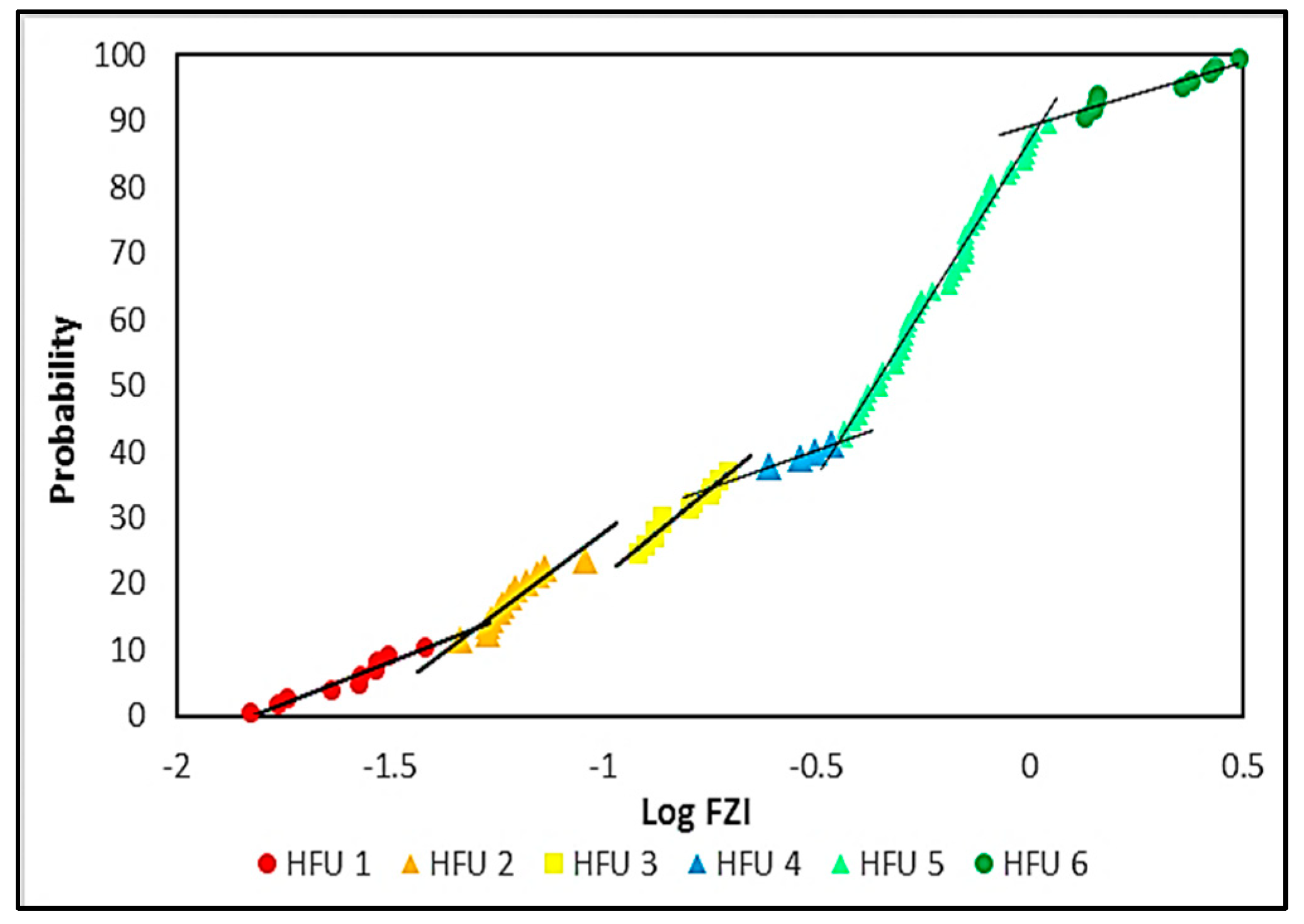


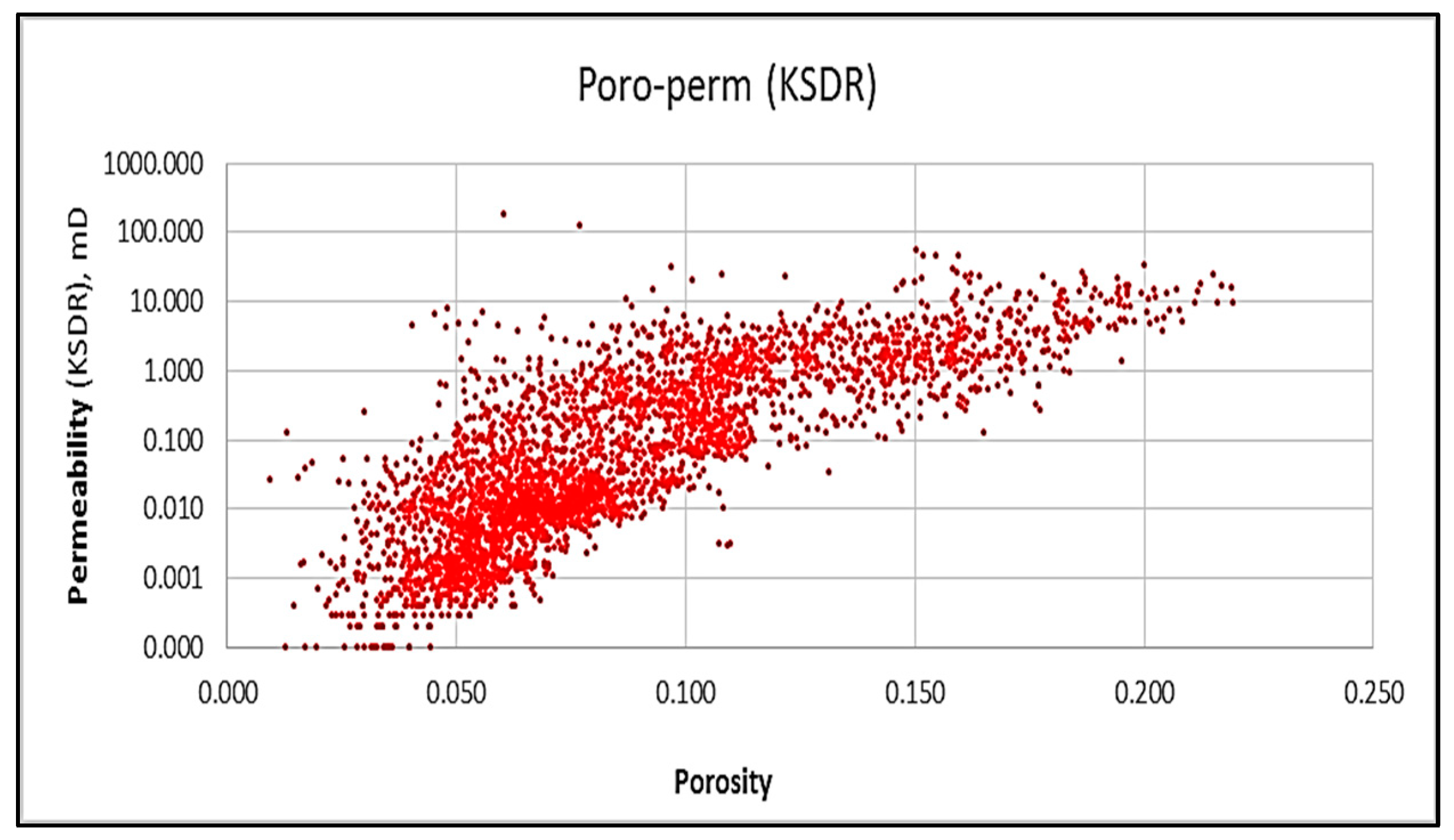

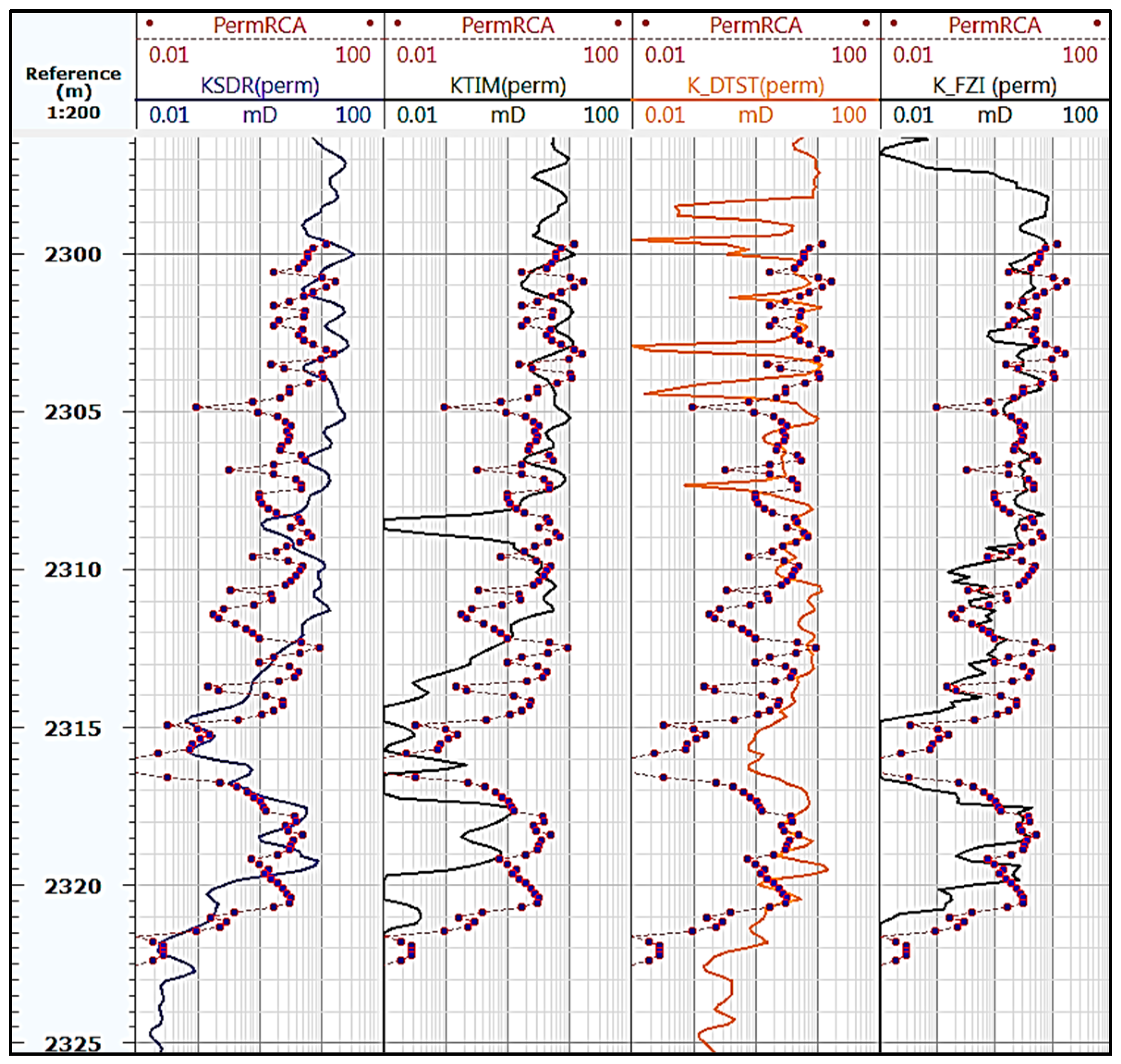


| No. | Category | Challenges |
|---|---|---|
| 1 | Petrophysical Challenges | Pore Structure: complexity and low porosity/permeability Reservoir Heterogeneity: variations in mineral composition and layering |
| 2 | Technological Limitations | Extraction Techniques: technical and financial challenges Recovery Rates: lower than conventional reservoirs |
| 3 | Economic Challenges | High Development Costs: capital-intensive technologies/methodologies Market Fluctuations: susceptibility to global oil prices |
| 4 | Environmental and Regulatory Challenges | Environmental Impact: groundwater contamination, induced seismicity Regulatory Hurdles: stricter regulations and policies |
| 5 | Geomechanical Challenges | Induced Seismicity: risks due to hydraulic fracturing. Reservoir Depletion: subsidence and altered stress regimes |
| 6 | Reservoir Management | Data Management: handling and interpreting vast data Reservoir Modelling: complexity due to heterogeneous nature |
| 7 | Infrastructure and Logistical Challenges | Accessibility: challenges in remote/offshore locations Supply Chain: ensuring robustness for materials and equipment |
| 8 | Human Resource Challenges | Expertise: shortage of skilled professionals Safety: ensuring personnel safety in demanding and hazardous environments |
| 9 | Social and Political Aspects | Social Acceptance: opposition to unconventional techniques Political Stability: risks in politically unstable regions |
| Petrophysical Analysis | Acquired Parameters | Used Software |
|---|---|---|
| Shale volume calculation | Shale (clay) volume | Geolog 7.4 |
| Porosity calculation | Total porosity, effective porosity | Geolog 7.4 |
| Reservoir rock/fluid substitutions | Mineralogy, water saturation, hydrocarbon saturation | Geolog 7.4 |
| Core data depth matching | Depth-matched core porosity/permeability | Techlog 2015 |
| Rock Typing | Rock Quality Index (RQI), Flow Zone Index (FZI), Hydraulic Flow Units (HFU) | Excel 2016 |
| Permeability estimation | NMR permeability, Stoneley permeability, permeability log equation | Geolog 7.4 and Excel |
| Pore structure investigation | VDL, pore type, capillary pressure (Pc), pore pressure, J function | Geolog 7.4 and Excel |
| Visualize output data | Layouts, charts, tables | Techlog 2015 |
| Well No. | Available Data (Nene Field) | |||||||||||
|---|---|---|---|---|---|---|---|---|---|---|---|---|
| CALI | GR | Density | Neutron | Resistivity | PEF | DTCO | DTS | CMR | Gas Shows | MDT/XPT | RCAL | |
| NNM-1 | * | * | * | * | * | * | * | * | * | * | * | |
| NNM-2 | * | * | * | * | * | * | * | * | * | |||
| NNM-2_Hor | * | * | * | * | * | * | * | * | * | |||
| NNM-3 | * | * | * | * | * | * | * | * | ||||
| Banga-M1 | * | * | * | * | * | * | * | |||||
| Method | Equation |
|---|---|
| Vsh − GR | |
| Vsh − NS | |
| Vsh − DN | |
| Vsh − DS |
| Method | Equation |
|---|---|
| PHIT_D | |
| PHIT_S | |
| PHIT_N | Read the value directly from the log |
| PHIT_ND | |
| PHIE |
| HFU 1 | Log FZI < −1.4 |
| HFU 2 | −1.4 < Log FZI < −1 |
| HFU 3 | −1 < Log FZI < −0.7 |
| HFU 4 | −0.7 < Log FZI < −0.45 |
| HFU 5 | −0.45 < Log FZI < 0.05 |
| HFU 6 | Log FZI > 0.05 |
| HFU 1 | Log FZI < −0.9 |
| HFU 2 | −0.9 < Log FZI < −0.7 |
| HFU 3 | −0.7 < Log FZI < −0.3 |
| HFU 4 | −0.3 < Log FZI < −0.15 |
| HFU 5 | −0.15 < Log FZI < 0.15 |
| HFU 6 | Log FZI > 0.15 |
Disclaimer/Publisher’s Note: The statements, opinions and data contained in all publications are solely those of the individual author(s) and contributor(s) and not of MDPI and/or the editor(s). MDPI and/or the editor(s) disclaim responsibility for any injury to people or property resulting from any ideas, methods, instructions or products referred to in the content. |
© 2023 by the authors. Licensee MDPI, Basel, Switzerland. This article is an open access article distributed under the terms and conditions of the Creative Commons Attribution (CC BY) license (https://creativecommons.org/licenses/by/4.0/).
Share and Cite
Gharavi, A.; Abbas, K.A.; Hassan, M.G.; Haddad, M.; Ghoochaninejad, H.; Alasmar, R.; Al-Saegh, S.; Yousefi, P.; Shigidi, I. Unconventional Reservoir Characterization and Formation Evaluation: A Case Study of a Tight Sandstone Reservoir in West Africa. Energies 2023, 16, 7572. https://doi.org/10.3390/en16227572
Gharavi A, Abbas KA, Hassan MG, Haddad M, Ghoochaninejad H, Alasmar R, Al-Saegh S, Yousefi P, Shigidi I. Unconventional Reservoir Characterization and Formation Evaluation: A Case Study of a Tight Sandstone Reservoir in West Africa. Energies. 2023; 16(22):7572. https://doi.org/10.3390/en16227572
Chicago/Turabian StyleGharavi, Amir, Karrar A. Abbas, Mohamed G. Hassan, Malik Haddad, Hesam Ghoochaninejad, Reham Alasmar, Salam Al-Saegh, Paria Yousefi, and Ihab Shigidi. 2023. "Unconventional Reservoir Characterization and Formation Evaluation: A Case Study of a Tight Sandstone Reservoir in West Africa" Energies 16, no. 22: 7572. https://doi.org/10.3390/en16227572







